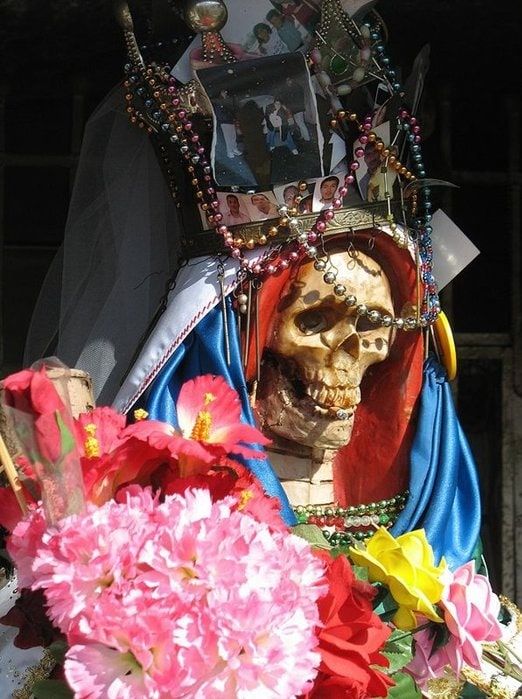The thing for the skeletal image: Devotion and origin of the cult to Santa Muerte
The cult to the skeletal image of Santa Muerte, as it is practiced today, emerged in the middle of the 20th century, but has its antecedents in the viceregal period.

Although the cult to Santa Muerte as it is known today, with the type of prayers and concept, does not go beyond the middle of the 20th century, the veneration of the skeletal image has its antecedents in colonial times. Death represents for many a taboo word and its mere mention produces silence, admiration, and fear, hence the need to break prejudices through the knowledge of its history, concept, allegory, and popular religiosity.
Although some pre-Hispanic ideas about death survived through the chronicles of the Spaniards, among them by Fray Bernardino de Sahagún in his History of the Things of New Spain, they were nuanced by the culture of the conquerors; likewise, archaeological remains are not enough to have a real parameter of what was thought about it in ancient Mesoamerica.
The icon of Santa Muerte comes from the macabre dances and some Greco-Latin designs, hence the presence of the scythe, the mantle, and the scales, to mention some elements. During the Colony, the evangelizing work focused on preparing devotees and converts to receive a "good death". This concept, together with that of death as punishment for the sin of Adam and Eve, and that of the Final Judgment, gave rise to a rich iconography captured in colonial art.
For example, at that time, large sculptures with skeletal images went out in procession on Good Friday. Of these, at least three are preserved in the country and are venerated to this day: the Santa Muerte de Yanhuitlán, which is visited in the former Dominican convent of that Oaxacan town; and those known as San Bernardo and San Pascual Bailón, in Tepatepec, Hidalgo, and Tuxtla Gutiérrez, Chiapas, respectively.
It is probable that the indoctrinated abstracted in these sculptural elements the Christian concepts about the "good death", so that they turned them into a motif of worship.
In colonial times, the Catholic Church saw this veneration of the skeletal image of death as heresy. According to inquisitorial documents of the XVII and XVIII centuries that I was able to consult, the reprisals were not directed to the people involved, but to the action itself, even in 1797, a chapel was razed in the town of San Luis de la Paz, where this cult was exercised. Already in the 19th century, after the disentailment of Church property, which also led to the secularization of the cemeteries, parishioners ceased to understand the Catholic sense of preparing for the "good death", and therefore of the image of death.
Thus a different iconography emerged, for example, the macabre dances and the representation of the Triumph of Death became something else, in such a way that they are retaken to make a political mockery, this was started by the caricaturist Gabriel Vicente Gahona ('Picheta') in the southeast, and years later by José Guadalupe Posada, with the image of La Catrina. Except for the image of the skeleton itself, the current popular religiosity around Santa Muerte, with its characteristics (a bricolage of ideas, syncretisms, and symbols taken from the Catholic religion, the Yoruba, or others), has little or nothing to do with that viceregal devotion.
It is not known who promoted it, but it is possible that between 1950 and 1960, the first holy cards circulated with this image and a specific prayer on the back, for that period those who prayed to him were mainly people who were in danger of death, either by their lifestyle or type of work. Housewives, doctors, or policemen approached her (Santa Muerte) in the same way; however, at the end of the nineties, the tabloids linked her cult to outlaw groups or people who live or work in the streets, after it became known that the kidnapper Daniel Arizmendi, alias "El Mochaorejas", captured in that decade, was a devotee of the image.
This devotion that emerged in the central region of the country has crossed the southern and northern borders, and even the Atlantic Ocean, because in Europe its iconography is taken up again as a kitsch element, so it is impossible to predict its duration because it has been updated and restructured, according to the needs of the moment and the tastes of those who profess this type of beliefs.
The leader of the cult of Santa Muerte dies
The cult leader of the "Santa Muerte" died. The well-known Madrina Enriqueta was a victim of cancer. Madrina Enriqueta took control of the temple after the murder of her son Jonathan on July 31, 2008, she was also recognized for officiating in criminal celebrations in the country. Enriqueta's body was veiled in the temple of Santa Muerte in Tultitlán.
Every year, during November and December, pilgrims from different parts of the State of Mexico and even people from different countries, since weddings and baptisms take place, it is common for same-sex couples to get married there. The leader had claimed that the cult of Santa Muerte, stopped being stigmatized since only criminals were followers but are now open for anyone, many children and families attend the temple every week.
The temple dedicated to Death is located next to the López Portillo road, in Santa María Cuautepec, Tultitlán. The temple has a monumental image of Death, 22 meters high, created by Enriqueta's son, Jonathan. It was inaugurated in 2007.
The Temple of Santa Muerte was visited by the North American writer, Andrew Chesnut, a renowned professor specializing in religious studies and author of the book Devoted to Death: Santa Muerte, The Skeleton Saint (Santa Muerte, la Cegadora Segura), where he mentions this place and Enriqueta's son, Jonathan. The writer says that the cult of Santa Muerte is the one that has grown the most in America in recent years since he estimated that there were some 10 million followers in Mexico, the United States, and Central America.
During his stay in Tultitlán in 2014, the writer explained that in his book he tried to paint a larger, more complex picture of who is Santa Muerte. He also mentioned that she is a saint who does many types of miracles, according to the devotees, also as a healer, symbol of justice, and for some merchants, as a source of prosperity.




